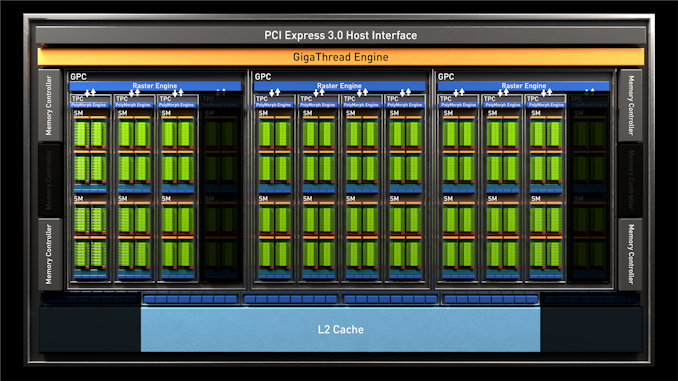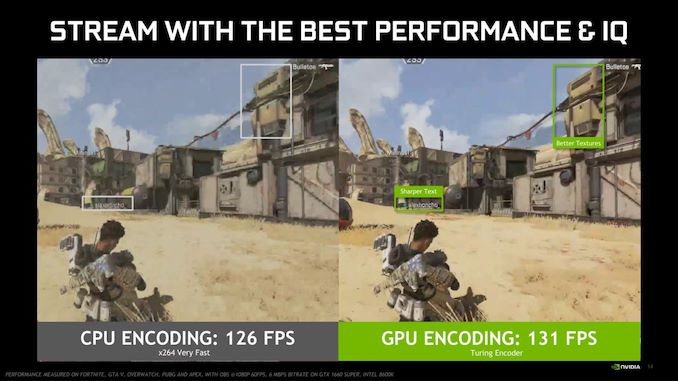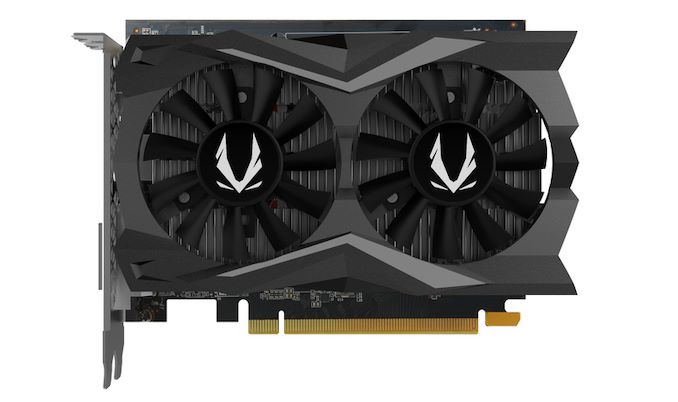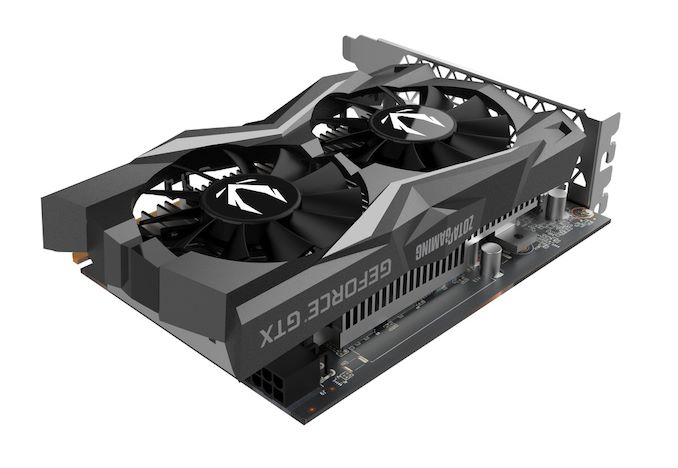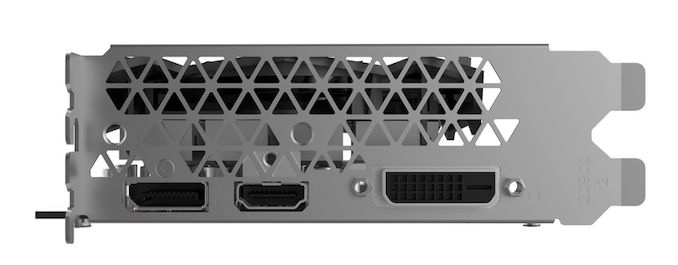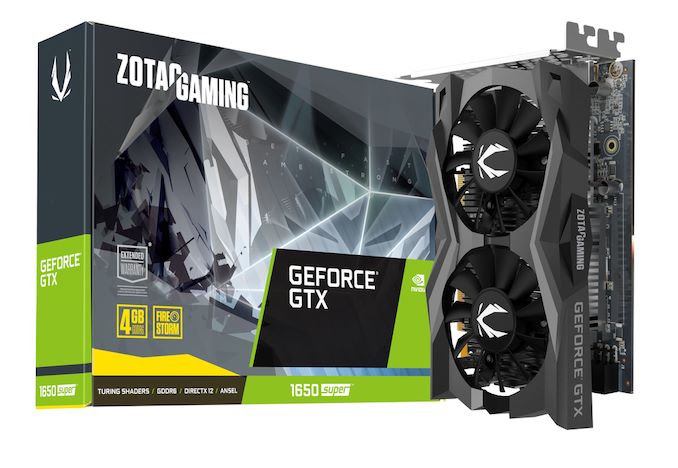
Original Link: https://www.anandtech.com/show/15090/the-nvidia-geforce-gtx-1650-super-review
The NVIDIA GeForce GTX 1650 Super Review, Feat. Zotac Gaming: Bringing Balance To 1080p
by Ryan Smith on December 20, 2019 9:00 AM EST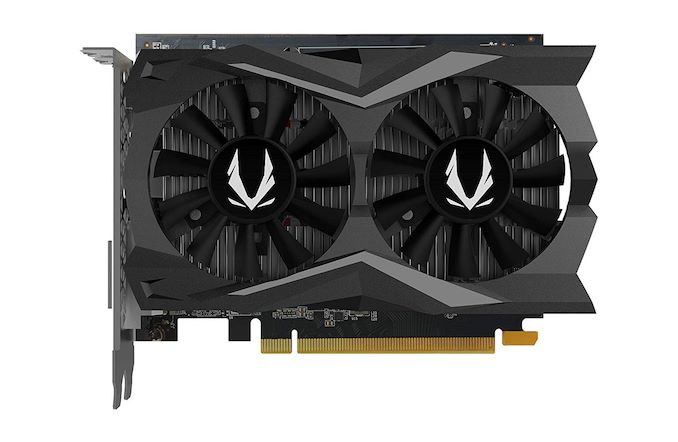
Bringing 2019 to a close in the GPU space, we have one final video card review for the year: NVIDIA’s GeForce GTX 1650 Super. The last of the company’s mid-generation kicker cards to refresh the lineup in the second-half of 2019, the GTX 1650 Super is designed to shore up NVIDIA’s position in the sub-$200 video card market, offering solid performance for 1080p gaming without breaking the bank. At the same time, it’s also NVIDIA’s response to AMD’s new Radeon RX 5500 XT series of cards, which having landed last week, significantly outperform the original GTX 1650.
Like the other Super cards, these refresh parts serve to shore up NVIDIA’s competitive positioning against AMD’s Radeon RX 5000 series cards, offering improved performance-per-dollar at every tier. NVIDIA has taken some flak for uncompetitive pricing, and this is not unearned. And it goes perhaps most for the original GTX 1650, which although is easily the best 75W card on the market, it’s always been surpassed in value by AMD’s cards; first the last-generation Polaris cards, and now the new Navi cards. So with the GTX 1650 Super, NVIDIA and its partners finally get a chance to rectify this with a more competitive part, that while no longer fitting into the original’s 75W niche, offers better performance all around.
| NVIDIA GeForce Specification Comparison | ||||||
| GTX 1660 | GTX 1650 Super | GTX 1650 | GTX 1050 Ti | |||
| CUDA Cores | 1408 | 1280 | 896 | 768 | ||
| ROPs | 48 | 32 | 32 | 32 | ||
| Core Clock | 1530MHz | 1530MHz | 1485MHz | 1290MHz | ||
| Boost Clock | 1785MHz | 1725MHz | 1665MHz | 1392MHz | ||
| Memory Clock | 8Gbps GDDR5 | 12Gbps GDDR6 | 8Gbps GDDR5 | 7Gbps GDDR5 | ||
| Memory Bus Width | 192-bit | 128-bit | 128-bit | 128-bit | ||
| VRAM | 6GB | 4GB | 4GB | 4GB | ||
| Single Precision Perf. | 5 TFLOPS | 4.4 TFLOPS | 3 TFLOPS | 2.1 TFLOPS | ||
| TGP | 120W | 100W | 75W | 75W | ||
| GPU | TU116 (284 mm2) |
TU116 (284 mm2) |
TU117 (200 mm2) |
GP107 (132 mm2) |
||
| Transistor Count | 6.6B | 6.6B | 4.7B | 3.3B | ||
| Architecture | Turing | Turing | Turing | Pascal | ||
| Manufacturing Process | TSMC 12nm "FFN" | TSMC 12nm "FFN" | TSMC 12nm "FFN" | Samsung 14nm | ||
| Launch Date | 03/14/2019 | 11/22/2019 | 04/23/2019 | 10/25/2016 | ||
| Launch Price | $219 | $159 | $149 | $139 | ||
From a pure hardware perspective, perhaps the most interesting thing about the GTX 1650 Super is that, unlike the other Super cards, NVIDIA is giving the new Super card a much bigger jump in performance over its predecessor. With a of 46%, increase in GPU throughput and faster 12Gbps GDDR6 memory, the GTX 1650 Super is much farther ahead of the GTX 1650 than what we saw with October’s GTX 1660 Super launch, relatively speaking.
The single biggest change here is the GPU. While NVIDIA is calling the card a GTX 1650, in practice it’s more like a GTX 1660 LE; NVIDIA has brought in the larger, more powerful TU116 GPU from the GTX 1660 series to fill out this card. There are cost and power consequences to this – the 284mm2 is a very large chip to be selling for $159 – but the payoff is that it gives NVIDIA a lot more SMs and CUDA Cores to work with. Coupled with that is a small bump in clockspeeds, which pushes the on-paper shader/compute throughput numbers up by just over 46%.
Such a large jump in GPU throughput also requires a lot more memory bandwidth to feed the beast. As a result, just like the GTX 1660 Super, the GTX 1650 Super gets the GDDR6 treatment as well. Here NVIDIA is using slightly lower (and lower power) 12Gbps GDDR6, which is attached to the GPU via a neutered 128-bit memory bus. Still, this one change gives the GTX 1650 Super 50% more memory bandwidth than the vanilla GTX 1650, very close to its increase in shader throughput.
Do note, however, that not all aspects of the GPU are being scaled out to the same degree. In particular, the GTX 1650 Super still only has 32 ROPs, with the rest of TU116’s ROPs getting cut off along with its spare memory channels. This means that while the GTX 1650 Super has 46% more shader performance, only has 4% more ROP throughput for pushing pixels. Counterbalancing this to a degree will be the big jump in memory bandwidth, which helps to keep those 32 ROPs well-fed, but at the end of the day the GPU is getting an uneven increase in resources, and gaming performance gains do reflect this at times.
The drawback to all of this, then, is power consumption. While the original GTX 1650 is a 75 Watt card – making it the fastest thing that can be powered solely by a PCIe slot – the Super-sized card is officially a 100 Watt product. This gives up the original GTX 1650’s unique advantage, and it means builders looking for even faster 75W cards won’t get their wish, but it’s the power that pays the cost of the GTX 1650 Super’s higher performance. Traditionally, NVIDIA has held pretty steadfast at 75W for their xx50 cards, but then again at the end of the day, despite the name, this is closer to a lightweight GTX 1660 than it is a GTX 1650.
Speaking of hardware features, besides giving NVIDIA a good deal more in the way of GPU resources to play with, the switch from the TU117 GPU to the TU116 GPU also has one other major ramification that some users will want to pay attention to: video encoding. Unlike TU117, which got the last-generation NVENC Volta video encoder block for die space reasons, TU116 gets the full-fat Turing NVENC video encoder block. Turing’s video encode block has been turning a lot of heads for its level of quality – while not archival grade, it’s competitive with x264 Medium – which is important for streamers. This also led to TU117 and the GTX 1650 being a disappointment in some circles, as an otherwise solid video card was made far less useful for video encoding. So with the GTX 1650 Super, NVIDIA is resolving this in a roundabout way, thanks to the use of the more powerful TU116 GPU.
Product Positioning & The Competition
As is always the case in the lower-end segment of NVIDIA’s product stack, the GTX 1650 Super is a pure virtual launch. This means that NVIDIA hasn’t put together a retail reference design, and all of the cards are based on partner designs.
At this point, the partners have been shipping TU116 and TU117-based cards for over 8 months, so they have been able to hone their GTX 16-series designs. This means that they’ve been able to hit the ground running, with existing designs ready for quick modification or straight reuse right away. The net result is that the newest GTX 1650 Supers look like and are built like the GTX 1660 and GTX 1650 cards that have preceded them.
Within NVIDIA’s product stack then, the GTX 1650 Super is not a wholesale replacement for the GTX 1650 – that card is still sticking around – but the GTX 1650 Super is going to be the value option for this performance segment. For consumers and OEMs who need 75W cards (for cooling or power reasons), then the $149 GTX 1650 remains the best choice. For everyone else, the GTX 1650 Super offers a whole lot more performance for $10 more. And while it’s not going to be performing on the same level as NVIDIA’s $200+ GTX 1660 cards, the GTX 1650 Super packs enough horsepower that it’s not going to be too far behind.
| NVIDIA GeForce 20/16 Series (Turing) Product Stack | ||||
| RTX 20 Series | GTX 16 Series | |||
| RTX 2080 Ti | GTX 1660 Ti | |||
| RTX 2080 Super | GTX 1660 Super | |||
| RTX 2070 Super | GTX 1660 | |||
| RTX 2060 Super | GTX 1650 Super | |||
| RTX 2060 | GTX 1650 | |||
It’s looking outside of NVIIDA’s product stack where we find the real competition for the GTX 1650 Super: AMD’s new Radeon RX 5500 XT series cards, particularly the $169 4GB model. While NVIDIA did not directly call out AMD when first revealing the GTX 1650 Super, the timing – between the RX 5500 series announcement and RX 5500 XT launch – leave no doubt in that respect. NVIDIA has been seemingly content to let AMD hold the $150-$200 market with their RX 580/570 cards, but with the latest AMD launch, that passive positioning has come to an end.
As I noted in last week’s RX 5500 XT review, there’s not quite a 1:1 match between Radeon and GeForce parts right now. The 4GB RX 5500 XT is $10 more expensive than the GeForce GTX 1650 Super, which as Ian Cutress made note of when we were discussing this article earlier this week, in the sub-$200 market customers are typically buying what they can afford. So even $10 matters in some cases. Still, it’s in NVIDIA’s best interests to meet or beat the RX 5500 XT 4GB on performance, to deny AMD that edge. And meanwhile NVIDIA generally has the edge on energy efficiency, though it’s no longer the one-sided fight it was against AMD’s Polaris-based RX 500 series cards.
Finally, the wild card factor here is once again going to be gaming bundles. NVIDIA doesn’t offer one, but AMD does. Along with a 3-month trial for Microsoft’s Xbox Games Pass program, the company is bundling the forthcoming “Master Edition” of Monster Hunter: Iceborne. We don’t often see game bundles with sub-$200 cards, so the inclusion of one can be a powerful factor in this segment of the market, since a game is a more significant fraction of the value of a card.
Though with most of Newegg’s video card stock being anything but in stock, just getting a card is a challenge right now. The first wave of GTX 1650 Super cards have done pretty well sales-wise, so the video card retailer has all of two models of GTX 1650 Super in stock, and Amazon is much the same.
| Holiday 2019 GPU Pricing Comparison | |||||
| AMD | Price | NVIDIA | |||
| Radeon RX 5700 | $319 | GeForce RTX 2060 | |||
| $279 | GeForce GTX 1660 Ti | ||||
| $229 | GeForce GTX 1660 Super | ||||
| Radeon RX 5500 XT 8GB | $199/$209 | GeForce GTX 1660 | |||
| Radeon RX 5500 XT 4GB | $169/$159 | GeForce GTX 1650 Super | |||
| $149 | GeForce GTX 1650 | ||||
Meet The ZOTAC Gaming GeForce GTX 1650 Super
Since this latest GTX 1650 series card launch is a virtual launch like the others, the board partners are once again stepping up to the plate to provide samples. For the GTX 1650 Super launch, we received Zotac’s Gaming GeForce GTX 1650 Super card, which is a fairly straightforward entry-level card for the series.
| GeForce GTX 1650 Super Card Comparison | ||||
| GeForce GTX 1650 Super (Reference Specification) |
Zotac Gaming GeForce GTX 1650 Super | |||
| Core Clock | 1530MHz | 1530MHz | ||
| Boost Clock | 1725MHz | 1725MHz | ||
| Memory Clock | 12Gbps GDDR6 | 12Gbps GDDR6 | ||
| VRAM | 4GB | 4GB | ||
| GPU Power Limit | 100W | 100W | ||
| Length | N/A | 6.24-inches | ||
| Width | N/A | 2-Slot | ||
| Cooler Type | N/A | Open Air, Dual Fan | ||
| Price | $159 | $209 | ||
For their sole GTX 1650 Super card, Zotac has opted to keep things simple, not unlike their regular GTX 1650 cards. In particular, Zotac has opted to design their card to maximize compatibility, even going as far as advertising the card as being compatible with 99% of systems. The end result of this being that rather than doing a large card that may not fit everywhere, Zotac has gone with a relatively small 6.2-inch long card that would be easily at home in a Mini-ITX system build.
Fittingly, there is no factory overclock to speak of here. With GPU and memory speeds identical to NVIDIA’s reference specifications, Zotac’s card is as close as you can get to an actual reference card. With is very fitting for our generalized look at the GeForce GTX 1650 Super as a whole.
Digging down, we start with Zotac’s cooler. The company often shifts between single fan and dual fan designs in this segment of the market, and for the GTX 1650 Super they’ve settled on a dual fan design. Given the overall small size of the card, the fans are equally small, with a diameter of just 65mm each. This is something to keep in mind for our look at noise testing, as small fans are often a liability there. Meanwhile the fans are fed by a single 2-pin power connector, so there isn’t any advanced PWM fan control or even RPM monitoring available for the fan. In this respect it’s quite basic, but typical for an NVIDIA xx50 series card.
Underneath the fan is an aluminum heatsink that runs most the length of the card. With a TDP of just 100 Watts – and no option to further increase the power limit – there’s no need for heatpipes or the like here. Though the heatsink’s base is big enough that Zotac has been able to cover both the GPU and the GDDR6 memory, bridging the latter via thermal pads. The fins are arranged vertically, so the card tends to push air out of the top and bottom.
The small PCB housing the GPU and related components is otherwise unremarkable. Zotac has done a good job here seating such a large GPU without requiring a larger PCB. As we usually see for such short cards, the VRM components have been moved up to the front of the board. The MOSFETs themselves are covered with a small aluminum heatsink, though with most of the airflow from the fans blocked by the primary heatsink, I don’t expect the VRMs are getting much in the way of airflow.
For power, the card relies on an 6-pin external PCIe power cable, as well as PCIe slot power. The power connector is inverted – that is, the tab is on the inside of the card – which helps to keep it clear of the shroud, but may catch system builders (or video card editors) off-guard the first time they install the card.
Finally for hardware features, for display I/O we’re looking at the same configuration we’ve seen in most GTX 1650 cards: a DisplayPort, an HDMI port, and a DL-DVI-D port. While DVI ports have long been banished from new products, there are still a lot of DVI monitors out there, particularly in China where NVIDIA’s xx50 cards tend to dominate. The tradeoff, as always, is that the DVI port is taking up space that could otherwise be filed by more DisplayPorts, so you’re only going to be able to drive up to two modern monitors with Zotac’s GTX 1650 Super. Of course, one could argue that a DL-DVI port shouldn’t even be necessary – this lower-end card isn’t likely to be driving a 1440p DL-DVI display – but I suspect this is a case where simplicity wins the day.
The Test
As Zotac’s GeForce GTX 1650 Super card is built to NVIDIA’s reference specifications, there is no need to dial it down or otherwise adjust the card to represent a reference card. As such, the card has been tested as-is.
Meanwhile, as with last week’s Radeon RX 5500 XT review, as the card is primarily focused on 1080p gaming and clearly underpowered for anything more than that, this is what our benchmark results will focus on.
As for drivers, we’re using the latest drivers from both NVIDIA and AMD for their cards. For NVIDIA cards, this is 441.41, and for AMD cards it’s AMD’s Radeon Software 19.12.2.
| CPU: | Intel Core i9-9900K @ 5.0GHz |
| Motherboard: | ASRock Z390 Taichi |
| Power Supply: | Corsair AX1200i |
| Hard Disk: | Phison E12 PCIe NVMe SSD (960GB) |
| Memory: | G.Skill Trident Z RGB DDR4-3600 2 x 16GB (17-18-18-38) |
| Case: | NZXT Phantom 630 Windowed Edition |
| Monitor: | Asus PQ321 |
| Video Cards: | AMD Radeon RX 5500 XT 8GB AMD Radeon RX 5500 XT 4GB AMD Radeon RX 580 AMD Radeon RX 570 AMD Radeon RX 460 4GB AMD Radeon R9 380 NVIDIA GeForce GTX 1660 Super NVIDIA GeForce GTX 1660 NVIDIA GeForce GTX 1650 Super NVIDIA GeForce GTX 1060 3GB NVIDIA GeForce GTX 1050 Ti |
| Video Drivers: | NVIDIA Release 441.41 NVIDIA Release 441.07 AMD Radeon Software Adrenalin 2020 Edition 19.12.2 |
| OS: | Windows 10 Pro (1903) |
Tomb Raider, F1 2019, & Assassin’s Creed
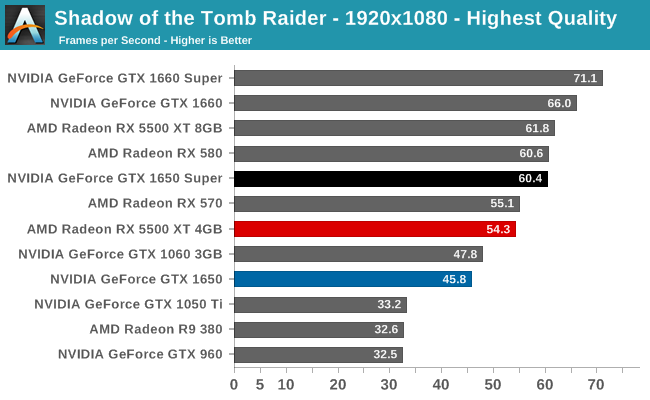
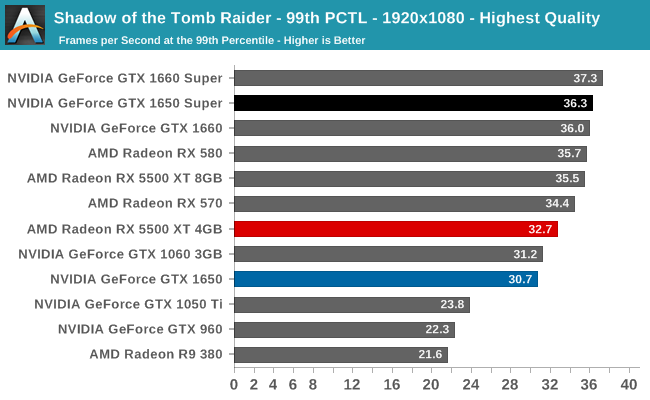
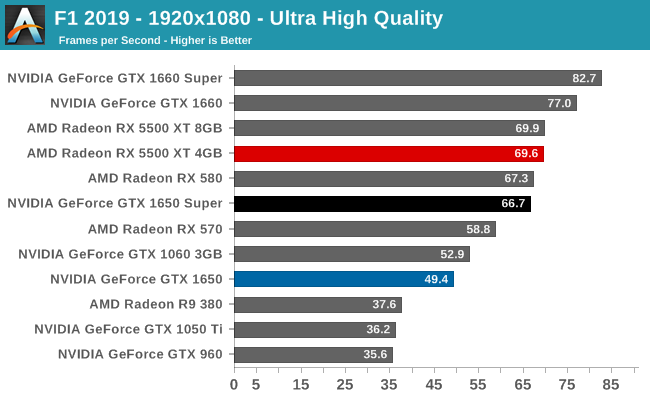
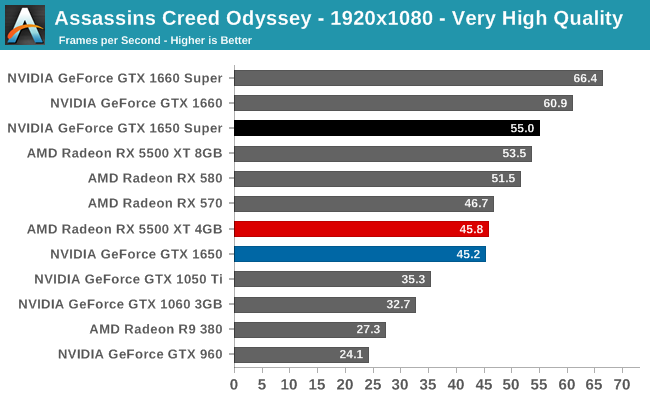
Metro Exodus, Strange Brigade, & Total War
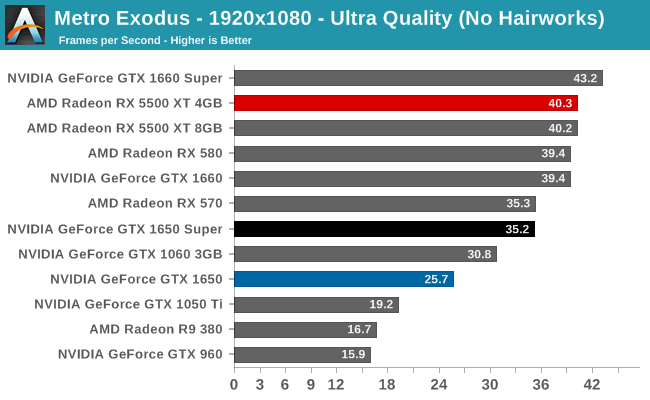
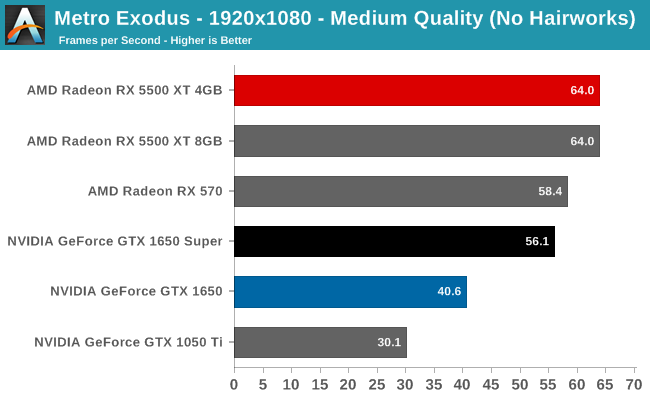
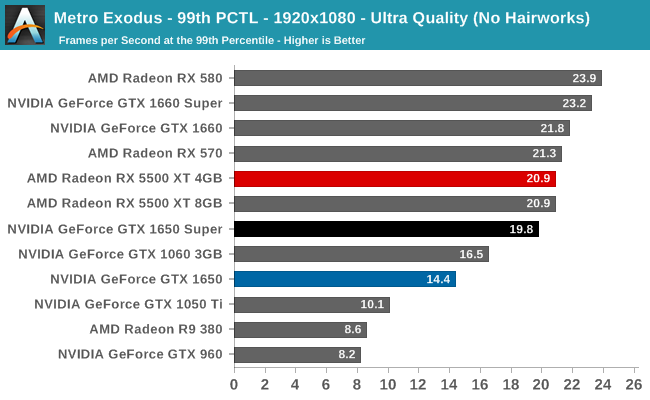
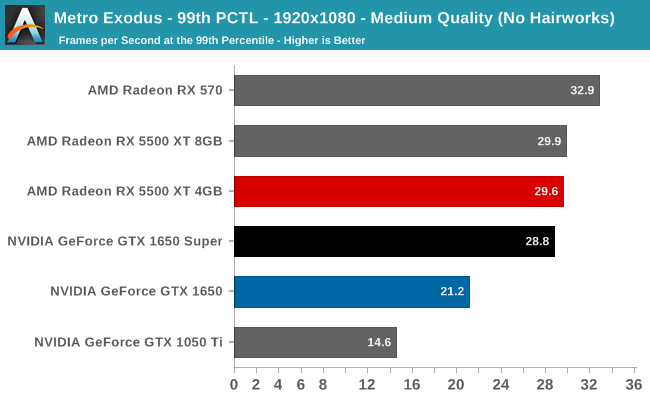
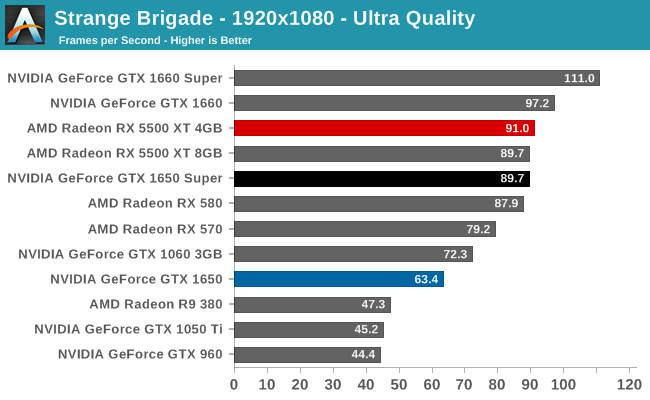
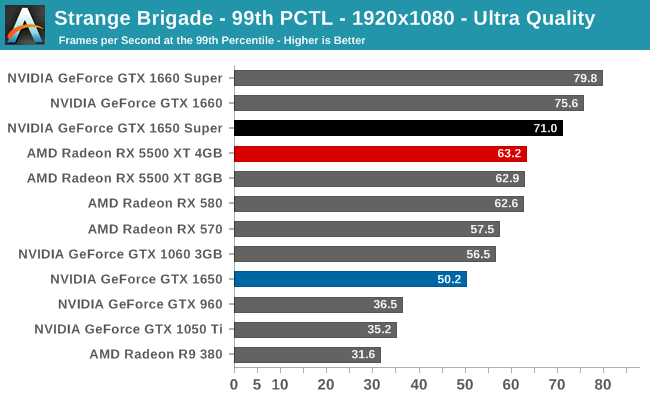
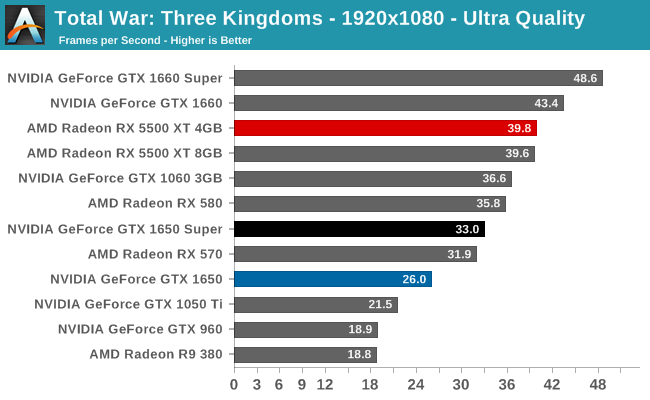
The Division 2, Grant Theft Auto V, & Forza Horizon 4
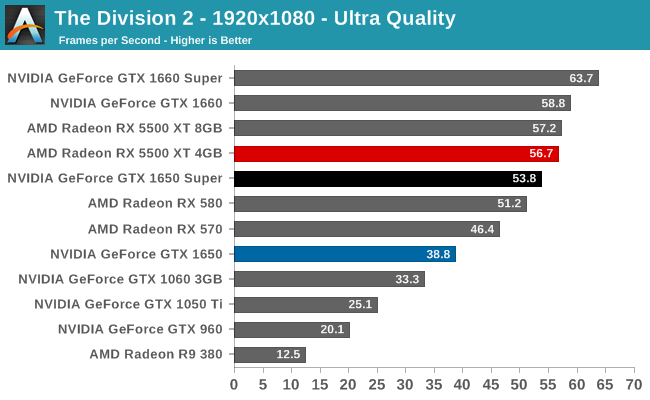
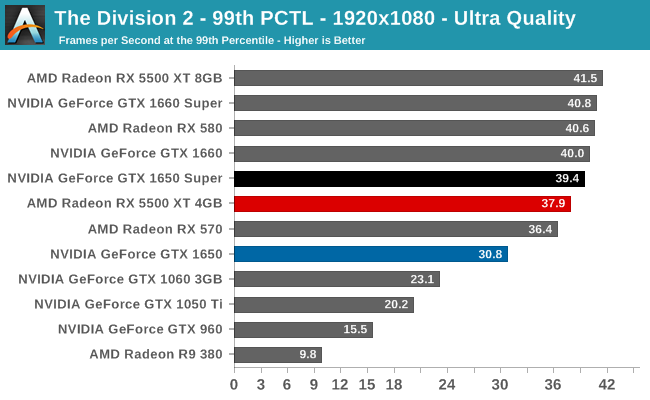
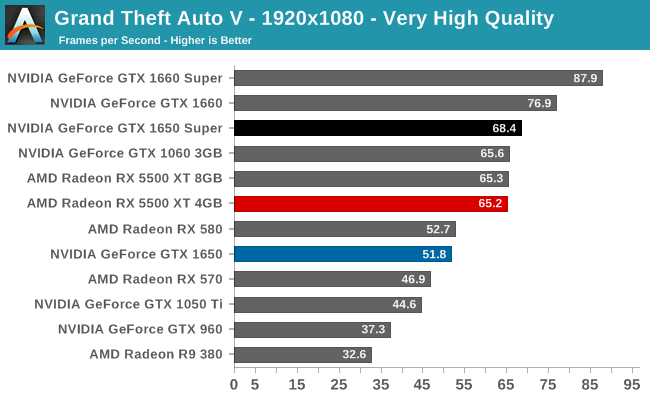
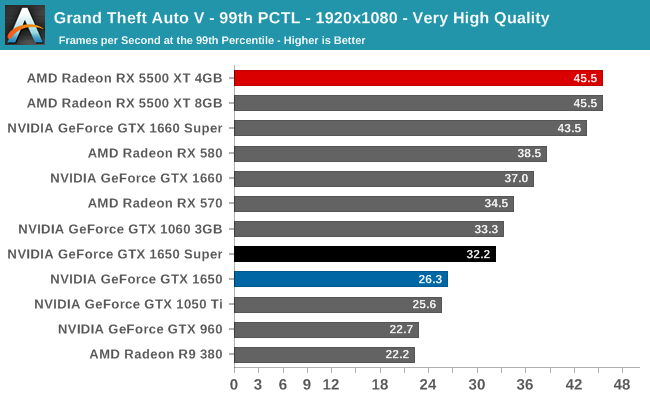
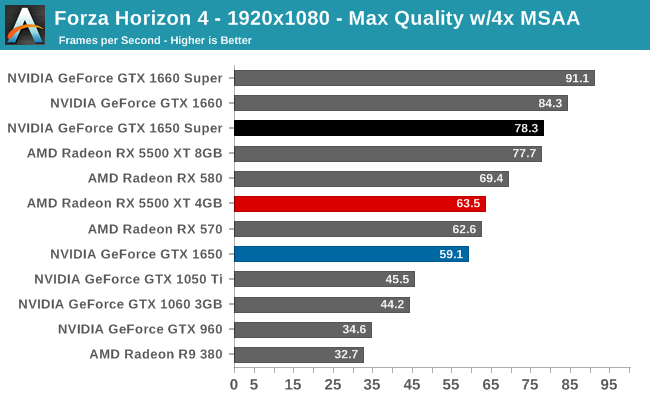
Compute
Along with our usual gaming results, we’ll also take a cursory look at compute performance for the GTX 1650 Super. This is one area where NVIDIA has developed an unusual advantage, at least for the moment, as AMD’s OpenCL driver for the Radeon RX 5000 series cards is currently broken and unfit for production use. I don’t expect anyone to be using a GTX 1650 Super for any serious compute work – generally if you need GPU compute, you’re after higher-end GPUs to really push performance – but if you do find yourself buying a $160 card for compute purposes, among modern cards NVIDIA is currently the only game in town for both OpenCL and CUDA.
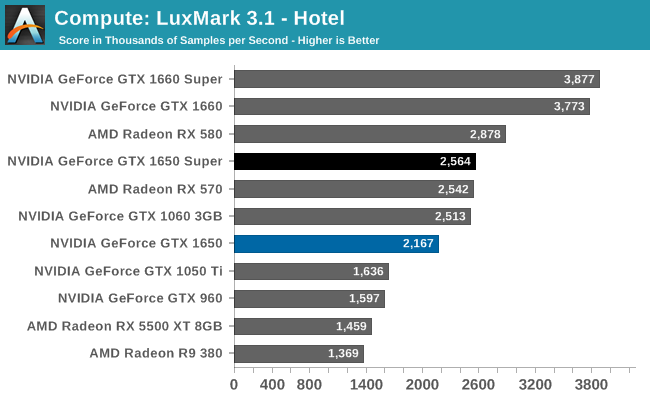
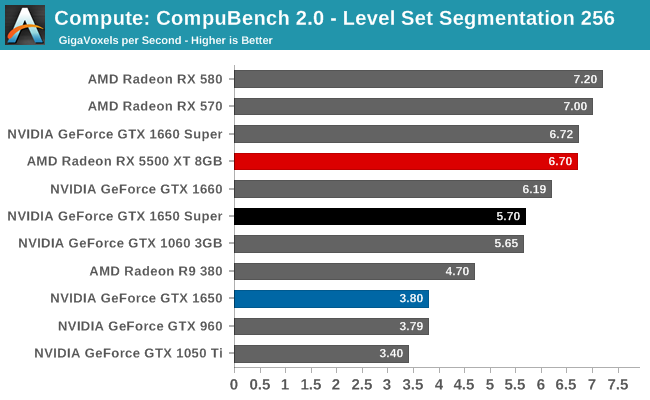
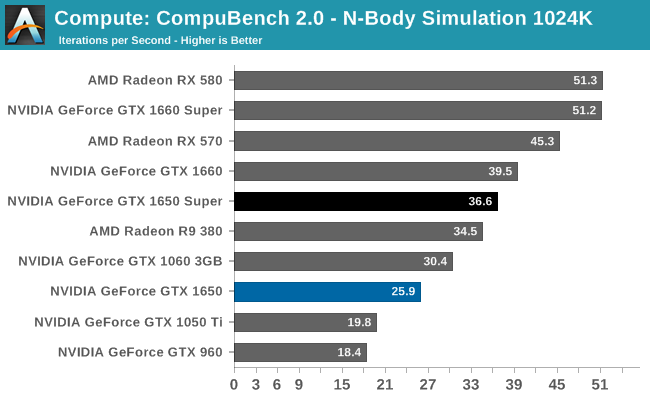
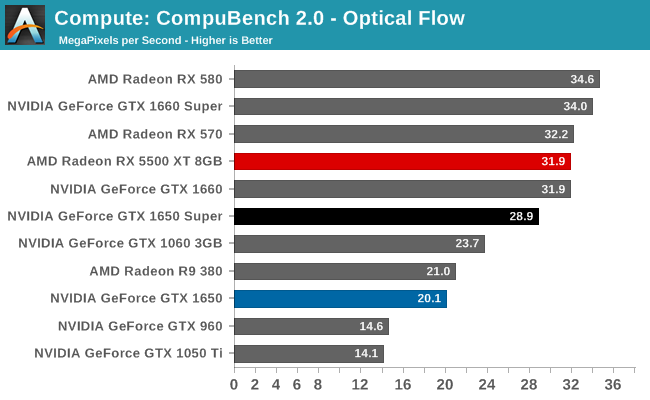
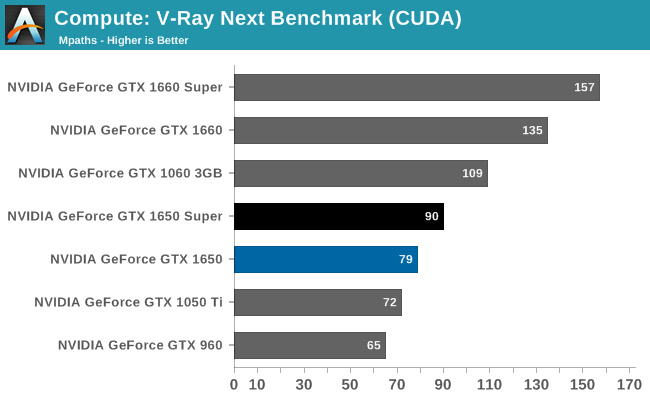
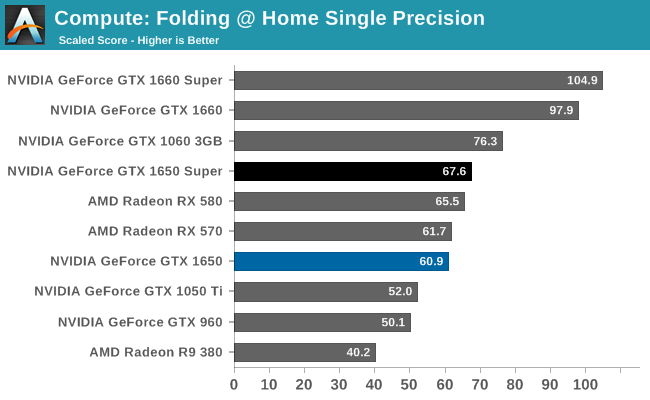
Synthetics
Moving on to synthetic performance testing, there shouldn’t be any surprises here. This is the 4th TU116 card we’ve looked at – albeit the first with just a 128-bit memory bus – so its behavior is generally well understood.
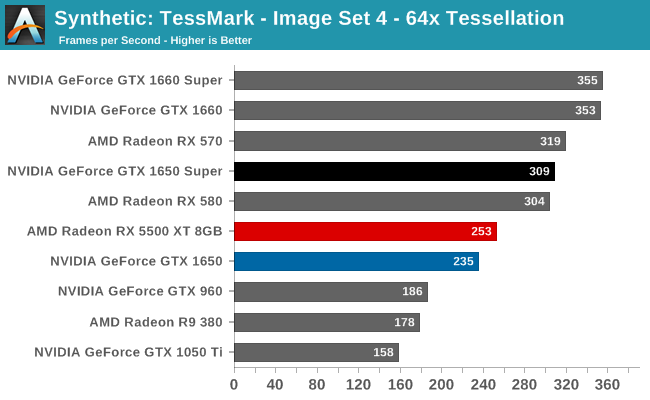
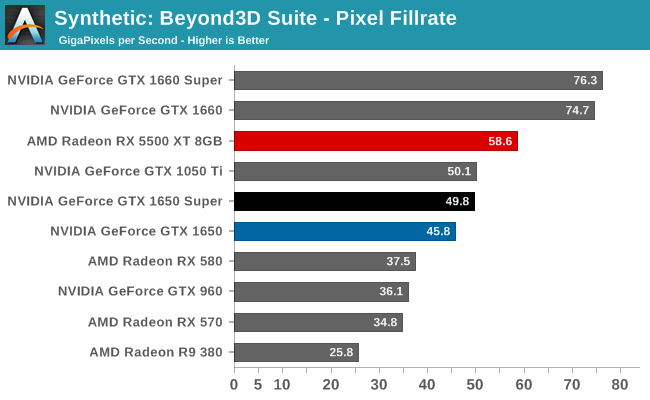
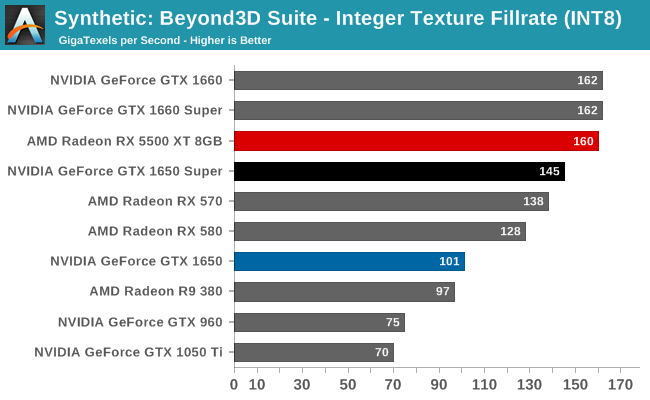
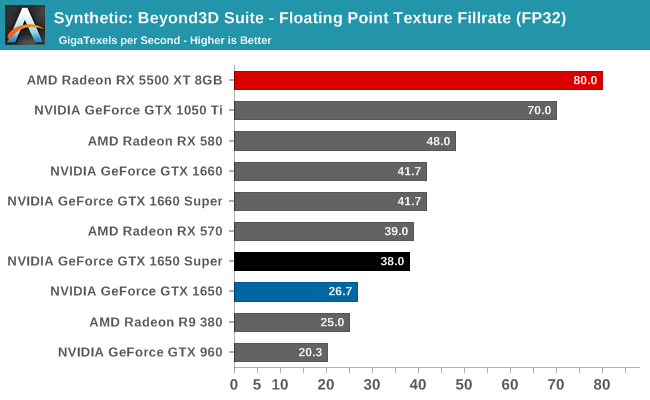
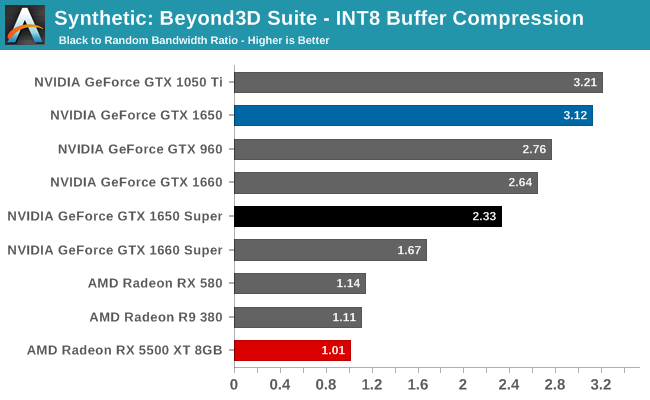
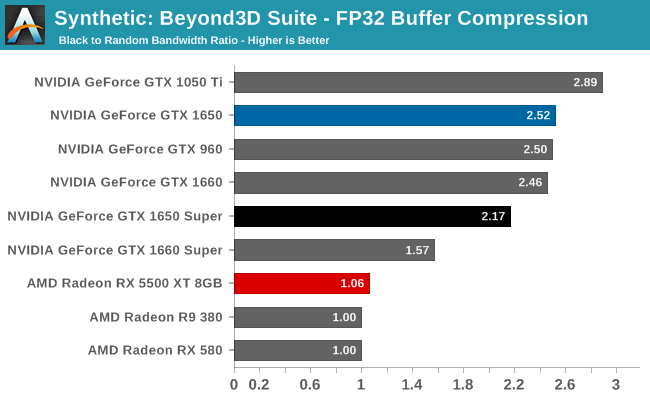
With synthetic performance, we see the GTX 1650 Super benefitting significantly with tessellation throughput, most likely due to the inclusion of more GPCs to house the greater SM count. This still leaves it behind the GTX 1660 cards, but relatively close overall. Meanwhile we see just a slight uptick in pixel throughput, reflecting the fact that while the card has a good deal more memory bandwidth than the regular GTX 1650, for this simple (and generally well compressible) test, it doesn’t add much.
Power, Temperature, & Noise
Last, but not least of course, is our look at power, temperatures, and noise levels. While a high performing card is good in its own right, an excellent card can deliver great performance while also keeping power consumption and the resulting noise levels in check.
| GeForce Video Card Voltages | |||||
| 1650S Max | 1660 Max | 1650S Idle | 1660 Idle | ||
| 1.05v | 1.05v | 0.65v | 0.65v | ||
If you’ve seen one TU116 card, then you’ve seen them all as far as voltages are concerned. Even with this cut-down part, NVIDIA still lets the GTX 1650 Super run at up to 1.05v, allowing it to boost as high as 1950MHz.
| GeForce Video Card Average Clockspeeds | ||||
| Game | GTX 1660 | GTX 1650 Super | GTX 1650 | |
| Max Boost Clock | 1935MHz | 1950MHz | 1950MHz | |
| Boost Clock | 1785MHz | 1725MHz | 1695MHz | |
| Shadow of the Tomb Raider | 1875MHz | 1860MHz | 1845MHz | |
| F1 2019 | 1875MHz | 1875MHz | 1860MHz | |
| Assassion's Creed: Odyssey | 1890MHz | 1890MHz | 1905MHz | |
| Metro: Exodus | 1875MHz | 1875MHz | 1860MHz | |
| Strange Brigade | 1890MHz | 1860MHz | 1860MHz | |
| Total War: Three Kingdoms | 1875MHz | 1890MHz | 1875MHz | |
| The Division 2 | 1860MHz | 1830MHz | 1800MHz | |
| Grand Theft Auto V | 1890MHz | 1890MHz | 1905MHz | |
| Forza Horizon 4 | 1890MHz | 1875MHz | 1890MHz | |
Meanwhile the clockspeed situation looks relatively good for the GTX 1650 Super. Despite having a 20W lower TDP than the GTX 1660 and an official boost clock 60MHz lower, in practice our GTX 1650 Super card is typically within one step of the GTX 1660. This also keeps it fairly close to the original GTX 1650, which boosted higher in some cases and lower in others. In practice this means that the performance difference between the three cards is being driven almost entirely by the differences in CUDA core counts, as well as the use of GDDR6 in the GTX 1650 Super. Clockspeeds don’t seem to be a major factor here.
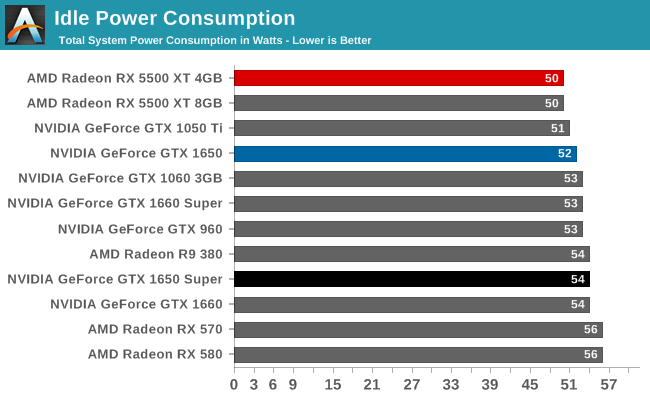
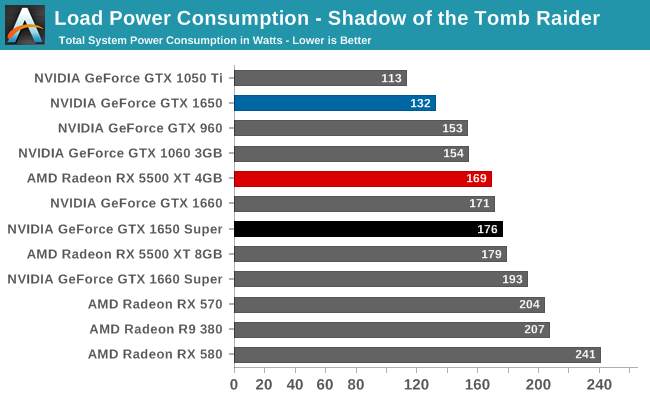
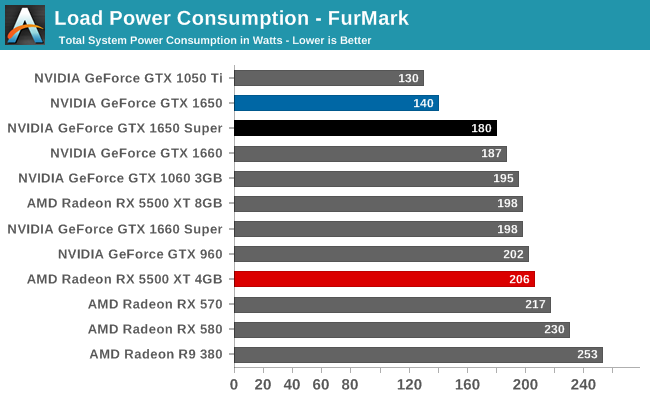
Shifting to power consumption, we see the cost of the GTX 1650 Super’s greater performance. It’s well ahead of the GTX 1650, but it’s pulling more power in the process. In fact I am a bit surprised by just how close it is (at the wall) to the GTX 1660, especially under Tomb Raider. While on paper it has a 20W lower TDP, in practice it actually fares a bit worse than the next level TU116 card. It’s only under FurMark, a pathological use case, that we see the GTX 1650 Super slot in under the GTX 1660. The net result is that the GTX 1650 Super seems to be somewhat inefficient, at least by NVIDIA standards. It doesn’t save a whole lot of power versus the GTX 1660 series, despite the lower performance.
Which also means it doesn’t fare especially well against the Radeon RX 5500 XT series. As with the GTX 1660, the RX 5500 XT is drawing less power than the GTX 1650 Super under Tomb Raider. It’s only by maxing out all of the cards with FurMark that the GTX 1650 Super pulls ahead. In practice I expect real world conditions to be between these two values – Tomb Raider may be a bit too hard on these low-end cards – but regardless, this would put GTX 1650 Super only marginally ahead of RX 5500 XT.
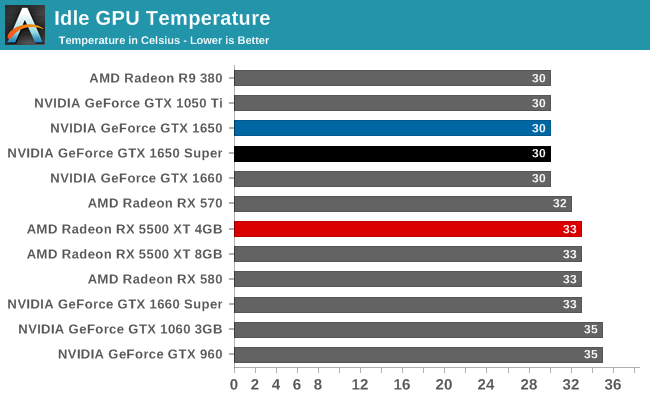
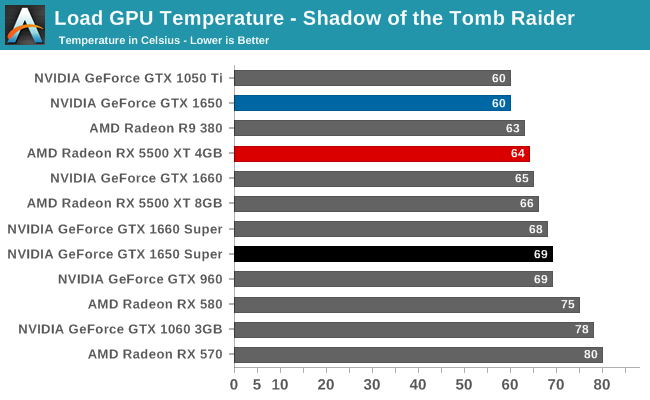
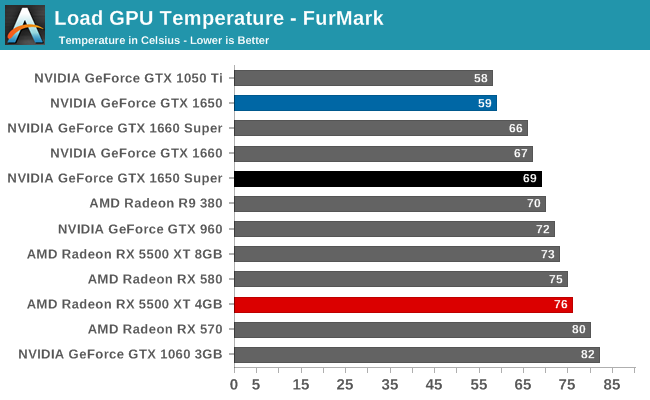
Looking at GPU temperatures, Zotac’s GTX 1650 Super card puts up decent numbers. While the 100W card understandably gets warmer than it’s 75W GTX 1650 sibling, we never see the GPU temperatures cross 70C. The card is keeping plenty cool.
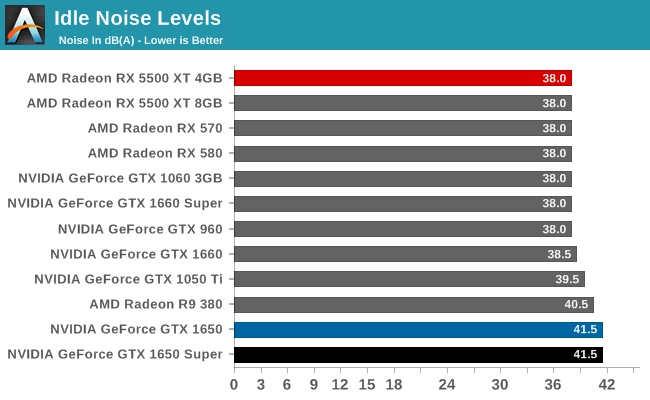
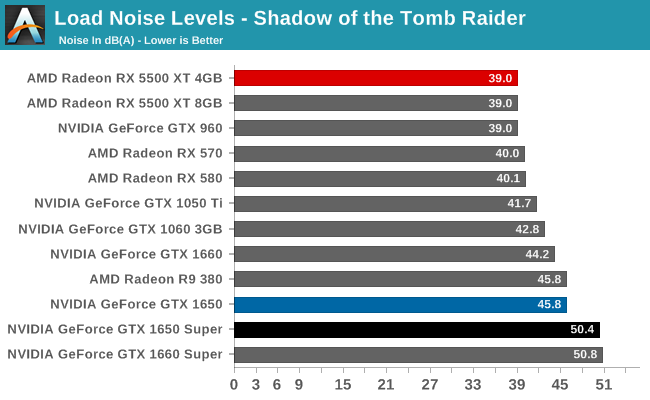
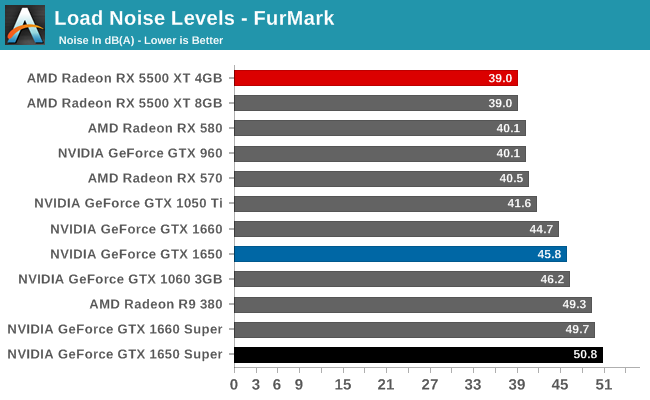
But when it comes time to measure how much noise the card is producing, we find a different picture. In order to keep the GPU at 69C, the Zotac GTX 1650 Super’s fans are having to do some real work. And unfortunately, the small 65mm fans just aren’t very quiet once they have to spin up. To be sure, the fans as a whole aren’t anywhere near max load – we recorded just 55% as reported by NVIDIA’s drivers – however this is still enough to push noise levels over 50 dB(A).
Zotac’s single-fan GTX 1650 card didn’t fare especially well here either, but by the time we reach FurMark, the GTX 1650 Super does even worse. It’s louder than any GTX 1660 card we’ve tested, even marginally exceeding the GTX 1660 Super.
All of this makes for an interesting competitive dichotomy given last week’s launch of the Radeon RX 5500 XT. The card we test there, Sapphire’s Pulse RX 5500 XT, is almost absurd in how overbuilt it is for a 130W product, with a massive heatsink and equally massive fans. But it moves more heat than Zotac’s GTX 1650 Super with a fraction of the noise.
If nothing else, this is a perfect example of the trade-offs that Sapphire and Zotac made with their respective cards. Zotac opted to maximize compatibility so that the GTX 1650 Super would fit in virtually any machine that the GTX 1650 (vanilla) can fit in, at the cost of having to use a relatively puny cooler. Sapphire went the other direction, making a card that’s hard to fit in some machines, but barely has to work at all to keep itself cool. Ultimately neither approach is the consistently better one – despite its noise advantage, the Sapphire card’s superiority ends the moment it can’t fit in a system – underscoring the need for multiple partners (or at least m multiple board designs). Still, it’s hard to imagine that Zotac couldn’t have done at least a bit better here; a 50 dB(A) card is not particularly desirable, especially for as something as low-powered as a GTX 1650 series card.
Final Words
For our final video card review of the year, the GeForce GTX 1650 Super admittedly doesn’t bring any surprises. But then it didn’t need to. As the 4th TU116 card released this year alone, and the 12th Turing GeForce card overall, we generally have a good grip on what the current generation of GeForce cards can do. All that’s really needed to change was for NVIDIA to get a better grip on what the market is looking for in performance for a sub-$200 card, and with the GTX 1650 Super they’re finally doing that.
Looking at things on a pure performance basis, the GTX 1650 Super makes significant strides over the GTX 1650, never mind NVIDIA’s last-generation cards. As it should: it offers a very hefty increase in the number of CUDA cores as well as memory bandwidth, and even with the TU116 GPU in its cut-down state for this card, it’s still just a whole lot more GPU than the TU117 in the GTX 1650. NVIDIA has thrown significantly more hardware at this segment, and the net result is a big performance boost.
And just in time as well. The launch of AMD’s rival Radeon RX 5500 XT immediately took the original GTX 1650 down a peg, as AMD’s card offered a lot more performance for only a small increase in price. So one way or another, the GTX 1650 Super is NVIDIA’s counter-play to AMD’s new card.
| Performance Summary (1080p) | |||||
| Relative Performance | Relative Price |
Relative Perf-Per-Dollar |
|||
| GTX 1650S vs GTX 1650 | +33% | +7% | +25% | ||
| GTX 1650S vs GTX 1660 | -11% | -24% | +16% | ||
| GTX 1650S vs GTX 1050 Ti | +77% | +14% | +55% | ||
| GTX 1650S vs RX 5500 XT 4GB | 0% | -6% | +6% | ||
The outcome is surprisingly even-handed between AMD and NVIDIA. With regards to framerates, the $159 GTX 1650 Super and the $169 RX 5500 XT 4GB are at a dead heat. As is usually the case, the cards are anything but equal on a game-by-game basis, constantly trading wins and losses, but at the end of the day they’re fighting over the same market with the same performance. NVIDIA has a slight edge in price, and perhaps an even slighter edge in overall energy efficiency, but that’s it. As a result, the GTX 1650 Super is significantly better than the GTX 1650, but it’s not able to meaningfully pull ahead of AMD’s card.
Meanwhile, although the original GTX 1650 is now well outclassed in terms of performance, the card isn’t going anywhere, and for good reason. It remains NVIDIA’s best option for the 75W market. GTX 1650 Super improves on performance by almost 33%, but it requires just as much additional power to get there. For system builds that aren’t sensitive to power/thermal needs, then this isn’t going to matter, and the GTX 1650 Super is well worth the $10 price premium. Otherwise the original GTX 1650 is still the best card available for the 75W, maximum compatibility PCIe-slot-power-only market.
Though like last week’s Radeon review, I’ll also note here my general hesitation with cards that have 4GB of VRAM. VRAM isn’t cheap, and GDDR6 even less so, so both vendors are using VRAM capacity as product differentiators and to upsell their better cards. But as VRAM capacity in the $150-$200 price range has been pretty stagnant for the last couple of years now, I do have some concerns about the long-term implications for 4GB cards, especially with the next-generation consoles set to launch in a year’s time. With the consoles setting the baseline for most multiplatform games, it’s a reasonable bet that VRAM requirements aren’t going to stay put at 4GB much longer.
Unlike AMD, the situation isn’t quite as black and white in the NVIDIA ecosystem, as NVIDIA doesn’t offer an 8GB GTX 1650 Super – or even an 8GB GTX 1660 series card for that matter. So the answer can’t just be “buy the 8GB card” like it is with the RX 5500 XT. Still, along with offering better performance, the GTX 1660 cards and their 6GB of VRAM stand a better chance of delivering solid, unimpeded gaming performance in a year or two’s time. At the end of the day, I don’t think any 4GB cards are a great choice right now; if you can afford to go higher, you should.
Finally, we have the particularities of Zotac’s card, the Zotac Gaming GeForce GTX 1650 Super. Zotac is one of NVIDIA’s most regular and reliable partners, and it shows, with the company producing a card that may just as well be the official GTX 1650 Super reference card. It is as good of an example of the baseline GTX 1650 Super experience as one could hope for, right on down to the fact that it’ll fit into virtually any PC.
But like it’s predecessor, the original Zotac GTX 1650, I remain unimpressed with the coolers on Zotac’s GTX 1650 series cards. We have seen and tested other similar double-slot cards before that are quieter, including cards from Zotac. So for the Zotac GTX 1650 Super land among the loudest of our low-end cards is unfortunate. While I admire Zotac’s commitment to making such a small card, I can’t help but think that, if nothing else, a single, larger fan would have fared better. Low-end cards are always a design challenge in terms of profit margins, but I think there’s room here for Zotac to do better, even for a baseline card like their Gaming GTX 1650 Super.

